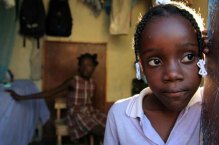Each day is filled with endless household chores from the time she wakes up until the time she goes to bed.
She is 7 years old. She is a restavek.
The term ‘restavek’ in Haitian Creole means literally ‘to stay with.’ Today it is one of the worst names to be called in Haitian society.
Originally conceived as a system to send children to live with wealthier relatives in the city so they could receive an education and enjoy a better life, the restavek system has deteriorated in recent years.
It has become a form of domestic trafficking and modern-day slavery, particularly in the face of the country’s increased economic pressures following the January 2010 earthquake.
Middlemen recruiters, known in Creole as koutchye, are sometimes paid to find a restavek for host families.
In addition to working long hours, these children are often physically, sexually, and verbally abused.
A System Gone Awfully Wrong
The irony is striking, given that Haiti established its independence in 1804 as a result of the only successful slave revolt in history, thereby making it the first free black republic in the world. That message of defiance and condemnation against the oppressive system of slavery was clearly heard across the globe.
Yet the practice of slavery continues in Haiti, this time against its most vulnerable citizens.
No Longer Invisible
On 15 June 2011, and under the auspices of the ILO, Haiti’s Ministry of Social Affairs and Labour, the US State Department and the Ministry of External Relations of Brazil signed a triangular cooperation agreement to abolish child labour in Haiti. It was the ILO’s first North-South-South triangular agreement.
Following this agreement, the ILO’s International Programme for the Elimination of Child Labour (IPEC) launched a new project in Haiti in December 2011, supported by the US and Brazil.
The project focuses on supporting institutional capacity-building and social dialogue to protect children from child labour, as well as on developing models to create decent work opportunities for teenagers. It also seeks to raise awareness in civil society about child labour in Haiti, particularly about the restavek system.
The Worst System of Child Labour in Haiti
“The restavek system is undoubtedly the worst form of child labour in Haiti, and it has continued to worsen in recent years. One in 10 Haitian children is a restavek, yet they remain invisible, hidden in the dark corners of homes and completely vulnerable to many forms of exploitation,” says Dr. Nancy Robinson, Chief Technical Advisor for IPEC in Haiti.
Together with local and international partner agencies, IPEC and the International Organization for Migration (IOM) have introduced another campaign called Frennen Sistem Restavèk La (End Restavek Abuse), which also aims to shine light on the restavek system and human rights abuses.
The campaign was officially launched in Port-au-Prince on 12 June 2012 to coincide with World Day against Child Labour. It marked the first time that the government, civil society, and the private sector came together with international partners to end this modern form of slavery.
Restaveks: Facts and figures
- According to UNICEF, there are an estimated 225,000 children, primarily female, between the ages of 5-17 living as restaveks in Haiti.
- Their average workday lasts 10 to 14 hours.
- Despite being responsible for preparing household meals, restaveks are usually fed only leftover food. As a result of malnourishment, the average 15 year old restavek stands 4cm shorter and weighs 20kg less than the average Haitian child.
- Haiti ratified the ILO Convention for the Elimination of the Worst Forms of Child Labour (Convention 182) in July 2007 and the Minimum Age Convention (Convention 138) in June 2009, both of which prohibit child slavery and protect the right of children to have access to free basic education.
- ILO Convention 182 identifies the worst forms of child labour, listing first and foremost, “slavery or practices similar to slavery, such as the sale and trafficking of children, debt bondage and serfdom and forced or compulsory labour” – all forms of labour implicated in the restavek system.
Source: ILO






